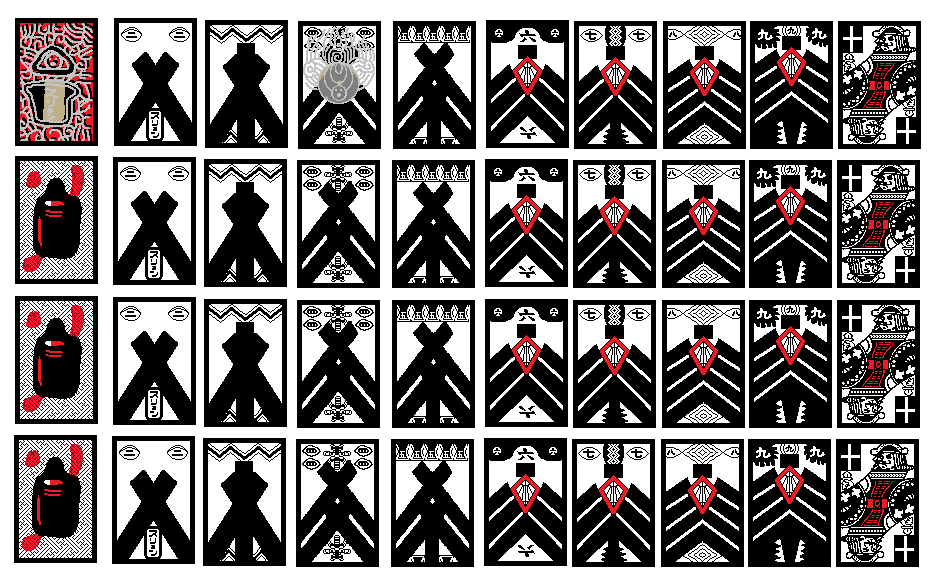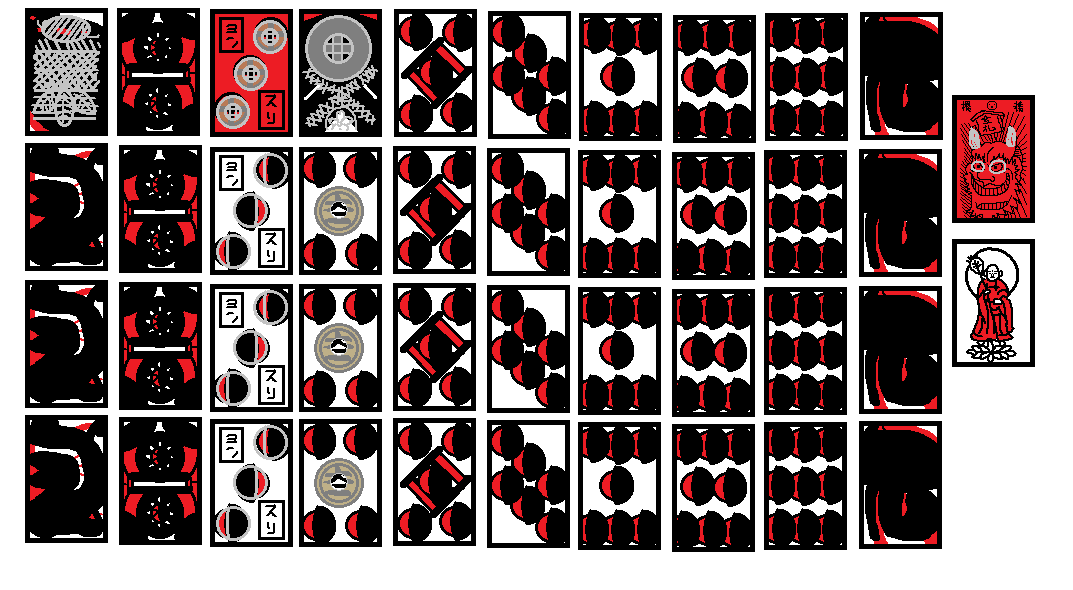Kyō-Kabu [京かぶ - きょうかぶ, lit. “capital nine”] is an Oicho-Kabu variant, played using a Kabufuda deck. It can be considered the predecessor of Oicho-Kabu.

It was attested to be also played using Mamefuda, a one-suited Mekurifuda deck with a similar structure to Kabufuda. Mamefuda include: Daini, Mefuda, and Komaru.

If you don’t have a Kabufuda deck, you may use a standard Hanafuda deck with all Willow
and Paulownia
cards removed; the values of the cards will be based on the month order.
The rules of this game are mostly identical to Oicho-Kabu, with some notable differences:
- Players are not dealt dead cards at the start of each round.
- The first field always consists of the cards 5, 6, 7, and 8.
- A player can only bet on one card during gameplay.
- The dealer can only draw from the top of the deck.
- There are less Special Yaku than in Oicho-Kabu.
¶ Setup
Game setup is the same as in Oicho-Kabu, except that after a dealer - 親 [おや, oya] has been chosen as well as the seating arrangement of the other players, the dealer sets up the first field before shuffling the deck.
The same equipment as in Oicho-Kabu (A deck of cards and colored chips for points) are also used in this game.
¶ Ground Rules
Before play begins, the group should agree on the following:
- What should happen in the event of a tie between a player and the dealer. There are two options: Either the result is a draw and the player’s bet is returned, or the dealer wins.
- The maximum total bet. This is a limit on the amount of points that can be wagered per round- the sum of all bets from all players cannot exceed it, and once it is reached, no further bets can be placed.
¶ Gameplay
Over the course of the round, each player attempts to form a hand whose total value is as close as possible to 9. Totals that go over 9 ‘wrap around’ by discarding the tens digit. So 10 is equivalent to 0, 11 is equivalent to 1, and so on, much like Baccarat. Similar to other banking games, the players are not competing against each other, but are only aiming to beat the dealer.
Only the dealer has a ‘hand’ in the traditional sense- the players hold no cards of their own. Instead, four hands are dealt to the table in a step-by-step process, and the players bet on the hands they consider most likely to win against the dealer’s.
¶ The First Field and Shuffling the Deck
The dealer starts by dealing 4 specific cards face-up to the table in a row: 5, 6, 7, and 8.




This is known as the first field- each of these four cards will form the basis of a hand.
The dealer then shuffles the deck, then passes it to the player on their right. This player may either cut the deck, or simply tap it to signal their satisfaction with the shuffle. The deck is then returned to the dealer, and play begins.
Variations of this process are common- for example, the deck may be passed around the entire table, being shuffled or cut by each player in turn, until it returns to the dealer.
¶ Betting
Starting from the right of the dealer and working anti-clockwise, the players take turns to bet on these potential hands. Each player may bet on only one card on the first field. They signal their bets by placing the appropriate number of chips on top of each card.
It is entirely possible for multiple players to bet on the same card- players are free to bet on cards that already have bets on them. (Different bets on the same card should be kept separate, however; different colours of chips will be useful here.)
Note that the total amounts of points bet by all players cannot exceed the agreed-upon maximum total bet. Players cannot make bets that would push the total over this limit, and if it is reached, no further bets may be made.
This means that, for example, if the total bet was 50, then the first player could immediately bet 50 points on their turn and prevent any of the other players from betting. This is, however, considered exceedingly rude.
¶ Dealer’s First Card
At this point, the dealer draws a card from the top of the deck and places it face-down in front of them, without looking at it. This card will be the first in the dealer’s hand.
¶ The Second Field
The dealer now deals 4 cards face-down to the table, one below each of the cards in the first field. This row is the second field [引き札 - ひきふだ, hikifuda], and each card forms a hand with the one above it; that is to say, each column of cards on the table is a hand.
Each player then looks at the face-down card for the hand that they have bet on, again without showing it to anyone else. Players cannot look at cards for hands they have not bet on.
At this point, each player should know the total value of the hands they’ve placed bets on, and how close each one is to 9.
¶ The Third Field
Moving anti-clockwise, the dealer asks each player in turn if they would like a third card [打ち札 - うちふだ, uchifuda] for their hand. If they say yes, then the dealer places a third card face-up below the hand in question, forming a third field of sorts.
If multiple players have bet on the same hand, then whichever of them is earliest in the turn order will get to make the decision.
There are two rules that affect this decision:
- If a hand’s total value is 3 or lower, then a third card must be taken.
- If a hand’s total value is 7 or higher, then a third card cannot be taken.
¶ Dealer’s Second Card
The dealer now adds a second face-down card to their hand. Once again, they may only draw this card from the top of the deck.
The dealer then looks at their hand and decides if they would like a third card. If so, they draw one, again keeping it hidden from the players.
¶ The Showdown
Finally, all cards are revealed. The second field cards are turned face-up, and the dealer lays out their hand for all to see. The dealer’s hand is then compared with each of the four hands on the table.
- If the dealer’s hand totals greater than a table hand, then the dealer wins; they take for themselves any bets placed on that hand by the players.
- If the dealer’s hand totals less the a table hand, then the players win. Any player who bet on that hand wins an amount equal to their bet, in addition to having their bet returned to them, for a total payout of 2:1.
- If the dealer’s hand and a table hand are equal in value, then this is a draw, and whichever rule the players agreed upon beforehand is applied. Either the dealer wins, or all bets on that hand are annulled and returned to the players.
This comparison is performed independently for each of the four hands- it is entirely possible for the dealer to win against some hands while losing against others.
¶ Special Yaku
There are two special Yaku that can affect the showdown:
-
Three of a Kind [ソロカブ - そろかぶ, sorokabu]: If the cards in the first, second, and third field are all the same value as any of the four cards on the first field (5, 6, 7, or 8), then this hand automatically wins against the dealer. Any players who bet on this hand receive double their bet in addition to having the original bet returned, for a payout of 3:1. Likewise, if all 3 cards of the dealer are of the same value as any of the four cards on the first field (5, 6, 7, or 8), then the dealer wins against all hands on the table that are not also Three of a Kind.
-
Dealer 9 and 1 [九一 - くっぴん, kuppin]: If the dealer’s first card is a 9 and their second is a 1, then they automatically win against all the hands on the table.


If the first, second, and third cards of the same value, do not have the values 5, 6, 7, or 8, then it is not counted as Three of a Kind.
Dealer 9 and 1 is order-sensitive- the first card must be a 9, and the second card must be a 1. It is not counted if the order is reversed, or if a third card is requested.
Players may also choose to play such that Dealer 9 and 1 is not order sensitive; Players should agree first to this rule before playing.
Dealer 9 and 1 wins against Three of a Kind, should they both occur together.
¶ End of the Game
The game is played for 12 rounds (it may also be played for 6 rounds; Players must agree first before playing), and the player with the most chips is the winner of the game.
¶ Terminology and Trivia
The terms for values used in Kyo-Kabu are slightly different to those used in Oicho-Kabu.
- One: unsun [ウンスン]
- Two: nizou [ニゾウ]
- Three: sanzun [サンズン]
- Four: yonzun [ヨンスン]
- Five: goken [ゴケン]
- Six: rokken [ロッケン]
- Seven: shichiken [シチケン]
- Eight: oicho [オイチョ]
- Nine: kabu [カブ]
- Ten: buta [ブタ]
¶ Mushi-Kabu (Kyo-Kabu variant)
It seems the game Kyo-Kabu was also played using Mushi-bana, a 40-card hanafuda deck similar to the standard hanafuda deck in design but with the ![]() Peony and
Peony and ![]() Bush Clover cards removed. In this case, the game is called Mushi-Kabu [虫カブ].
Bush Clover cards removed. In this case, the game is called Mushi-Kabu [虫カブ].
To compensate for the removed suits, the ![]() Willow suit was used to replace the
Willow suit was used to replace the ![]() Peony suit, while the
Peony suit, while the ![]() Paulownia suit was used to replace the
Paulownia suit was used to replace the ![]() Bush Clover suit. (See “Mushi” Month Sequence)
Bush Clover suit. (See “Mushi” Month Sequence)